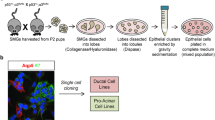Summary
This study reports the isolation and characterization of a rat nontumorigenic parotid acinar cell clone (2RSG), a human nontumorigenic parotid acinar cell clone (2HPC8), and a human tumorigenic acinar clone (2HP1G). The levels ofα-amylase mRNAs detected when usingα-amylase cDNA of 1176 and 702 bp for hybridization were higher in 2RSG and 2HPC8 cells than their respective whole parotid glands. The level of these mRNAs decreased in 2HP1G cells. In contrast toα-amylase mRNAs levels, theα-amylase activity in cultured acinar cells was extremely low in comparison to whole glands, irrespective of species or cell status. The levels of proline-rich protein (PRP) mRNA and parotid secretory protein (PSP) mRNA detected when using PRP cDNA of 600 bp and PSP cDNA of 805 bp for hybridization were higher in 2RSG cells than those in rat parotid glands; the reverse was observed in 2HPC8 cells and human parotid glands. The levels of PRP mRNA and PSP mRNA in 2HPC8 and 2HP1G acinar cells were similar. The level of mRNA was not detectable in murine neuroblastoma cells (NBP2) using the sameα-amylase cDNA, PRP cDNA and PSP cDNA for hybridization. The PSP level in rat parotid gland was lower than that found in 2RSG cells; the reverse was observed in 2HPC8 cells and human parotid glands. The level of PSP in 2HP1G cells was higher than that found in 2HPC8 cells. Isoproterenol increased the cAMP level in 2RSG, 2HPC8, and 2HP1G clones, being most effective in 2RSG cells, and least effective in 2HPG cells. Prostaglandin E1 (PGE1) also increased cAMP level, being most effective in 2HPC8 cells and ineffective in 2HP1G cells, suggesting that the PGE1 receptor-linked adenylate cyclase becomes inactive upon transformation. These results suggest that the three clonal acinar cells from rat and human parotid glands reported here can be useful in comparative studies on regulation of growth, differentiation, and transformation.
Similar content being viewed by others
References
Baum, B. J.; Colpo, F. T.; Filburn, C. R. Characterization and relationship to exocrine secretion of rat parotid gland cyclic AMP-dependent protein kinase. Arch. Oral Biol. 26:333–337; 1981.
Baum, B. J.; Frieberg, J. M., Ito, H., et al. Beta-adrenergic regulation of protein phosphorylation and its relationship to exocrine secretion in dispersed rat parotid gland acinar cells. J. Biol. Chem. 256:9731–9736; 1981.
Brown, B. L.; Albano, J. D. M.; Ekins, R. P., et al. A simple and sensitive saturation assay method for the measurement of adenosine 3′,5′-cyclic monophosphate. Biochem. J. 121:561–562; 1971.
Butcher, F. R.; Putney, J. R. Regulation of parotid gland functions by cyclic nucleotide and calcium. Adv. Cyclic Nucleotide Res. 13:215–249; 1980.
Chomezymski, P.; Sacchi, N. Simple-step method of RNA isolation by acid guanidiumthiocyanate-phenol-chloroform extractions. Anal. Biochem. 162:156–159; 1987.
Chopra, D. P.; Xue-Hu, I. C. Secretion of alpha-amylase in human parotid gland epithelial cell culture. J. Cell. Physiol. 155:223–233; 1993.
Harper, J. R. Stimulus-secretions coupling: Second messenger-regulated exocytosis. Adv. Second Messenger Phosphoprotein Res. 22:193–198; 1988.
Jahn, R.; Unger, C.; Soling, H. D. Specific protein phosphorylation during stimulation of amylase secretion by beta-agonist or dibutyryl adenosine 3′,5′-monophosphate in the rat parotid gland. Eur. J. Biohem. 112:345–352; 1980.
Kousvelari, E.; Tabak, L. A. Genetic regulation of salivary protein in rodents. Crit. Rev. Oral Biol. Med. 2:139–151; 1991.
Leslie, B. A.; Putney, J. W.; Sherman, J. M. Alpha-adrenergic, betaadrenergic, and cholinergic mechanisms for amylase secretion by rat parotid glands in vitro. J. Physiol. 260:351–370; 1976.
Lowry, O. H.; Rosebrough, N. J.; Farr, A. L., et al. Protein measurement with the Folin phenol reagent. J. Biol. Chem. 193:265–275; 1951.
Mednieks, M. I.; Hand, A. R. Cyclic AMP-dependent protein kinase in stimulating rat parotid gland cells. Compartmental shifts after in vitro treatment with isoproterenol. Eur. J. Cell Biol. 28:264–271; 1982.
Oliver, C.; Walters, J. F.; Tolbert, C. L., et al. Growth of exocrine acinar cells on a reconstituted basement membrane gel. In Vitro Cell. Dev. Biol. 23:456–473; 1987.
Poulsen, K.; Jakobsen, K. B.; Nielsen, T. J., et al. Coordination of murine parotid secretory protein and salivary amylase expression. EMBO J. 5:1891–1896; 1986.
Prasad, K. N.; Carvalho, E.; Edwards-Prasad, J., et al. Establishment of human parotid pleomorphic adenoma cells in culture: Morphological and biochemical characterization. In Vitro Cell. Dev. Biol. 30A:312–320; 1994.
Prasad, K. N.; Carvalho, E.; Edwards-Prasad, J., et al. Establishment and characterization of immortalized cell lines from rat parotid glands. In Vitro Cell. Dev. Biol. 30A:321–328; 1994.
Prasad, K. N.; Carvalho, E.; Kumar, S., et al. Relationship between adenosine 3′,5′-cyclic monophosphate level, cell proliferation, andα-amylase in rat parotid. Biochem. Cell Biol. 71:355–360; 1993.
Quissell, D. O.; Deisher, L. M.; Barzen, K. A. The rate determining step in cAMP mediated exocitosis in the rat parotid and submandibular gland appears to involve analogous 26-KDa integral membrane phosphoproteins. Proc. Natl. Acad. Sci. USA 82:3237–3241; 1985.
Sabatini, L. M.; Allen-Hoffman, B. L.; Varner, T. F., et al. Serial cultivation of epithelial cells from human and macaque salivary glands. In Vitro Cell. Dev. Biol. 27A:939–948; 1991.
Sambrook, J.; Fritsch, E. F.; Maniatis, T. Molecular cloning. A laboratory manual. 2nd ed. Cold Spring Harbor, NY: Cold Spring Harbor Laboratory; 1989.
Yeh, C. K.; Mertz, P. M.; Oliver, C., et al. Cellular characteristics of long-term cultured rat parotid acinar cells. In Vitro Cell. Dev. Biol. 27A:707–712; 1991.
Author information
Authors and Affiliations
Rights and permissions
About this article
Cite this article
Prasad, K.N., Kumar, S., Carvalho, E. et al. Characterization of human and rat immortalized clones of parotid acinar cells with respect to specific proteins and their mRNAs, and receptor-linked adenylate cyclase. In Vitro Cell Dev Biol - Animal 31, 767–772 (1995). https://doi.org/10.1007/BF02634118
Received:
Accepted:
Issue Date:
DOI: https://doi.org/10.1007/BF02634118




